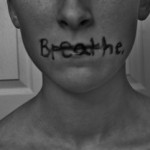2
Feb 13
Planes, trains and handshakes: finding your anxiety triggers
You’re sitting on a crowded bus, and suddenly your heart rate spikes, your breathing becomes irregular, and you get an overwhelming sense of dread. You’re going for a nice long run, and then suddenly you feel like the world is closing in around you and you can’t breathe. You’re at a party having fun, and then your ex walks in and you feel your hands trembling, your palms sweating, and your temperature spiking.
In all of these cases, you are experiencing some form of anxiety. It seems like the anxiety came out of the blue, but something must have caused it, right? Most certainly. Anxiety triggers will be very different for most of you. If you have social anxiety, you might get anxious when you have to give a presentation or when you’re forced to be assertive. If you’re a panicker like me, you may get anxious when your heart rate rises or your breathing becomes irregular. If you’re obsessive-compulsive, you might find that intrusive thoughts are causing anxiety.
Here is a simple step-by-step guide to help you identify your anxiety triggers. I suggest that you keep a small journal handy to document your experiences.
- Be vigilant. Stay focused on your feelings, and try to pinpoint exactly when a wave of anxiety starts. Note your heart rate, your breathing, your trembling, and your emotions. The first step to identify your anxiety triggers is to notice the exact moment when your anxiety starts (this can be harder than it sounds).
- Record your surroundings. Have a journal or notebook handy. Write down everything you can about your physical environment. Where are you? What are you doing? Are you alone or with friends? Are you in public? Be as objective as you can.
- Record your thoughts. Much of your anxiety comes from your false beliefs and assumptions. Take some time to write down what you’re thinking about when the anxiety starts. Are you having negative thoughts? Are you worrying about a future event? Are you overly conscious of other people around you? Try to figure out what it is that’s making you fear the situation.
- Keep recording for a week. Every time you start feeling anxious for the next week, record everything you can about the situation (remember to look internally as well!). The biggest obstacle you’ll face here is hypothesis myopia: you will start to develop an idea of what’s causing your anxiety, and only notice evidence that supports your hypothesis (this is called a confirmation bias – we’ll talk more about that later). Keep being objective! Record everything, not just what you think is important.
- Go back and analyze your records. Remember to start looking at your findings without a prior hypothesis. Sometimes, I’m surprised to see that every time I get anxious, I happen to be thinking about something I never imagined could be a trigger. Look for commonalities in your journal: were most of your anxious episodes surrounding public transportation? Was a certain person around? Were you having recurring, intrusive thoughts? Was it a smell, a particular sensation, a bright light? Triggers can be very general (like open areas) or incredibly specific (like the smell of pine needles on a cold day in the dark). You may be surprised by what seems to be causing your anxiety.
- Take note of your triggers. This isn’t an exact science (well, it’s not really science at all), so you may not be able to find all your triggers. You may have some triggers that you rarely come across (I’m terrified of heights, but I’m not usually dangling over the side of a building so I don’t think about it very often). You may even have some triggers that you never experience anymore because you’re avoiding something (I hate answering the phone, so I avoid it at any cost). The more triggers you can identify, the more control you will develop over your symptoms. The scariest part of anxiety is the not knowing; the times when the anxiety strikes for no apparent reason. Develop a list of your triggers, and see whether or not they persist over time. The ones that do persist are probably the ones closer to the root of your problem.
To give you an example to get you started, I will describe a recent anxiety-provoking situation of my own. I was down in my basement running on the treadmill, and I suddenly noticed I was panicking. I’m certainly not new to this whole anxiety-tracking business, so I took note of everything around me and everything I was thinking and feeling. I realized that there were two main things causing the panic: superficially, it was the strained breathing signalling to my brain that I was under stress; but really, the trigger was my own negative thinking. I was worrying that because my breathing was becoming strained after only 10 minutes of running, I was severely out of shape and I would never build up the endurance I wanted to. My thoughts wandered over to Failureland, that part of your mind that loves to tell you that you’re failing at something. Over the past two years, I’ve realized that most of my triggers surround my perfectionism.
Keep in mind that your triggers will probably change over time. If you’re anywhere near as suggestible as I am, you may find that reading about other people’s triggers will cause you to develop new triggers. The biggest step you can make in your journey to recovery is to identify what is making you anxious. Then, you can take the steps to figure out why a particular situation, thought, or feeling is making you that way. We are really trying to get to the why. There’s a reason we’re anxious. I hope that in finding that reason, it will help us get better.
Leave me a comment! I would love to hear what your triggers are. If you have any questions for me, feel free to leave them below! I love answering questions (seriously).








